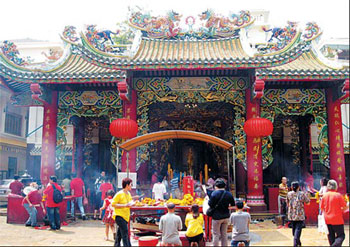By Erik Nilsson
About one in 10 Thais claim Chinese ancestry, and today, Bangkok's Chinatown is the site of their umbilical ties to the motherland.
This becomes abundantly clear upon strolling Chinatown's labyrinthine streets, which are festooned with enough stuff from the Middle Kingdom for any Sinophile to get their fix.
More than in other part of Bangkok, the street system here resembles the cross-section of a lung, tapering from roads into lanes into alleyways like the branching of bronchi into bronchioles.
A handful of sites of interest are constellated throughout the neighborhoods - temples, archways and historical buildings - but Chinatown's real appeal comes from the sum of its parts rather than an individual area.

Bangkok's Chinatown is one of the world's oldest, a hive of activity packed with vendors and temples. Erik Nilsson
It's the way the district's food stalls and shops synthesize to create a hive of activity that buzzes with a distinctly Chinese vim.
The nerve center is Sampeng Lane. It was the first street in Chinatown when the district was established in 1782. That year, King Rama I relocated the capital to Bangkok from Thonburi, which had been the site of emigration for southern Chinese throughout the 18th century.
Today, Chinatown is among the oldest neighborhoods in Bangkok, and Bangkok's Chinatown is among the oldest in the world.
Upon coming to Bangkok, these Chinese, most of whom were laborers in the old capital, traded in their tools for textiles and became merchants.
Over the centuries, Sampeng Lane maintained its reputation as a hub of commerce, and the compacted pedestrian street is congested with vendors peddling a plethora of goods.
Just north of the lane's western terminus is Thieves Market (Nakhon Kasem). Today, it is known as a prime place for treasure-hunting antiquarians, rather than a spot to sell pilfered products.
Running parallel of Sampeng Lane to the north is Yaowarat Road, arguably the heart of the district since its construction under King Rama V.
Odean Gate was constructed in 1999, in celebration of the 72nd birthday of the current monarch, King Bhumibol Adulyadej. Princess Maha Chakri Sirindhorn wrote the inscription on its sign plate, which reads: "Long Live the King."
According to local folklore, the gate was constructed near the head of the fabulous Golden Dragon, whose body is believed to wind through Yaowarat. For centuries, the dragon has been believed to be the steward of the community to whom the Thai-Chinese are indebted for their prosperity.
Wat Traimit - Chinatown's most famous temple - is a diminutively sized building that is home to the world's largest solid gold Buddha.
Hailed as one of the best examples of the Sukhothai style of craftsmanship, the 3-m-tall, 5-ton figure is estimated to be worth $14 million, according to literature distributed at the site.
It is believed to have been cast sometime in the 13th century and at some point was coated in plaster to conceal it from bandits.
The disguise did the trick - so well, in fact, so that nobody gave the statue much thought until it was relocated to Wat Traimit in 1955. One of the movers accidentally cracked the plaster, exposing the gold sheen underneath.
A stairway leads to the balcony of the wat, where a coin-operated device tells fortunes according to the Chinese zodiac. Upon feeding 10 baht to the coin slot, lights flash, gears whir and the contraption spits out a slip of paper with a fortune printed in Chinese, Thai and English.
A westbound walk across the street brings visitors to the Thian Fa Foundation. The charity was founded by Chinese Mahayana Buddhists from five regions in 1902, to provide modern and traditional Chinese medical treatment for the poor.
Further east, Yaowarat is chockablock with heavily guarded gold stores and restaurants with window displays showcasing collections of gauzy shark fins. Most of the capital's Chinese restaurants - 44, according to the Thailand Tourism Authority - are found here.
Wat Mangkon Kamalawat, located on Charoen Kamalawat Road to the north of Yaowarat, is the central site for major festivals, especially Vegetarian Festival, which falls on the ninth month of the Chinese lunar calendar - usually between September and October on the Roman calendar.
In addition to abstaining from meat, as well as pungent vegetables, such as onions and garlic, the zealously observant also perform extraordinary acts, such as fire-walking, and driving blades and hooks through their cheeks.
Just northeast of Mangkon Kamalawat is Wat Kanikaphon. This temple is said to have been founded by a brothel madam who underwent a spiritual rebirth later in life. Also, the less remarkable but quaint Li Thi Miew Shrine is located a few minutes' walking distance southwest of Mangkon Kamalawat.
But the district's biggest attraction for temple trippers is Wat Chakrawat. This is the largest monastery in the district and the third largest in the city. And, curiously enough, two of its ponds are home to sizeable crocodiles.
(China Daily March 13, 2008)